| Columns Retired Columns & Blogs |
HRT Music Streamer USB D/A Converter Measurements
Sidebar 3: Measurements
I examined the measured behavior of the Music Streamer using the Audio Precision SYS2722 system (see www.ap.com and "As We See It" in the January 2008 issue), as well as, for some tests, my Audio Precision System One Dual Domain and the Miller Audio Research Jitter Analyzer. I drove the Music Streamer with the USB 2.0 output of my Intel MacBook running OS10.4.11 for the testing, playing back WAV files using Bias Peak 6.2 and operating off battery power. As the Streamers are bus-powered, I wondered if it was possible that they might perform slightly differently with different computers. However, as they use internal voltage regulation for their circuits, I suspect that this won't be an issue.
This bargain-priced little box uses the same PCM2706 USB receiver chip as the Music Streamer+ but with a PCM1744 DAC chip. It locked to data with sample rates of 44.1 and 48kHz and had a maximum output level at 1kHz of 2.16V. The signal was absolute polarity-correct and was sourced from the same impedance as the Streamer+, 246 ohms, at low and middle frequencies, this dropping slightly at 20kHz, to 226 ohms. The Music Streamer's frequency response (fig.1) suffered from a little more passband ripple in the treble than is usually the case, which appears to be characteristic of the PCM1744, according to its datasheet. The Streamer's channel separation (not shown) was excellent at >100dB below 1.5kHz, and a still respectable 87dB at 20kHz.
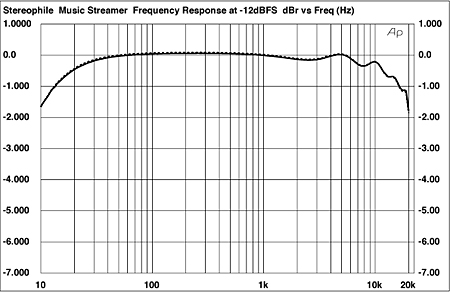
Fig.1 HRT Music Streamer, frequency response at –12dBFS into 100k ohms, 44.1kHz data (right channel dashed; 1dB/vertical div.).
I looked at the DAC's resolution both by sweeping a 1/3-octave bandpass filter down from 20kHz to 20Hz (fig.2) and by performing an FFT analysis (fig.3). The Music Streamer's decoding of 16-bit data representing a dithered 1kHz tone at –90dBFS indicated a higher-than-usual level of noise and significantly negative linearity error, the latter confirmed by looking at the error plot (fig.4). The Music Streamer is limited to 16-bit data, but even so, its resolution is closer to 14 bits. The background noise obscured the waveform of an undithered tone at exactly –90.31dBFS (fig.5) that should consist of three well-defined DC voltage levels (see the result for the Cambridge DacMagic).
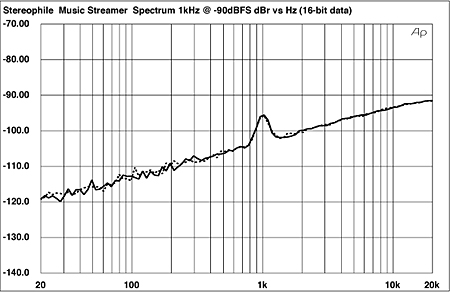
Fig.2 HRT Music Streamer, 1/3-octave spectrum with noise and spuriae of dithered 1kHz tone at –90dBFS, 16-bit data (right channel dashed).
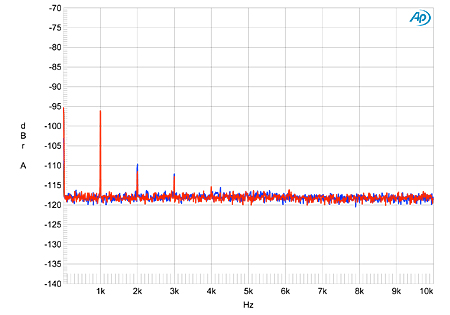
Fig.3 HRT Music Streamer, FFT-derived spectrum with noise and spuriae of dithered 1kHz tone at –90dBFS, 16-bit data (left channel blue, right red).
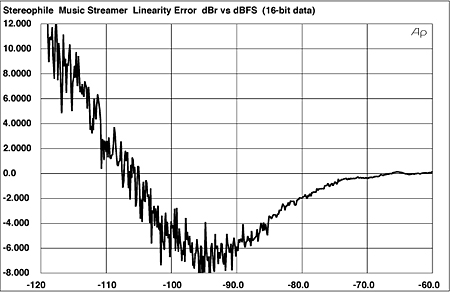
Fig.4 HRT Music Streamer, left-channel linearity error, 16-bit data (2dB/vertical div.).
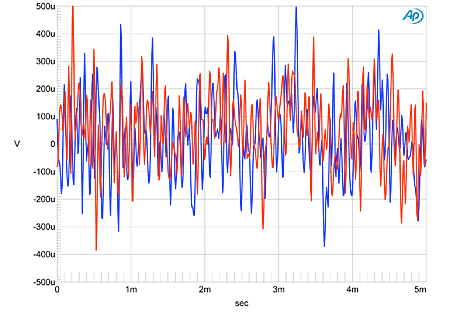
Fig.5 HRT Music Streamer, waveform of undithered 1kHz sinewave at –90.31dBFS, 16-bit data (left channel blue, right red).
The Music Streamer's output stage doesn't seem fazed by low impedances; fig.6 shows the spectrum of its output while it drove a full-scale 50Hz tone into 600 ohms. The highest-level distortion harmonic is the subjectively innocuous second, at –76dB (0.015%), and the levels of the higher-order harmonics drop with increasing order. This picture was not appreciably different into the more reasonable 100k ohm load, though the third harmonic predominated at midrange frequencies (not shown). Tested with the demanding mix of high-level 19 and 20kHz tones, the Music Streamer's intermodulation signature comprised the higher-order products at 18 and 21kHz (both just above –60dB or 0.1%), though the slow rolloff of the digital filter used results in fairly strong images of the tones above 20kHz (fig.7).
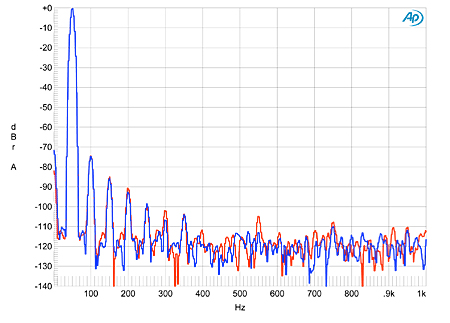
Fig.6 HRT Music Streamer, spectrum of 50Hz sinewave at 0dBFS into 600 ohms, 16-bit data (left channel blue, right red; linear frequency scale).
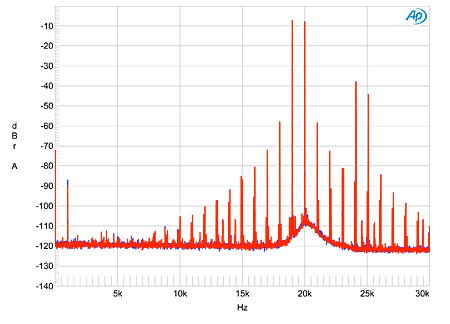
Fig.7 HRT Music Streamer, HF intermodulation spectrum, 19+20kHz at 0dBFS peak into 100k ohms, 16-bit data (left channel blue, right red; linear frequency scale).
Finally, as is usually the case with the PCM270x series of USB chips, the Music Streamer produced moderately high levels of jitter, the Miller Analyzer calculating there to be 720 picoseconds peak–peak of jitter-related sidebands in the analog output signal while the Music Streamer decoded the 16-bit jitter diagnostic tone. The spectrum of the DAC's output, taken with the Audio Precision SYS2722, is shown in fig.8: there is some spectral spreading of the central peak that represents the 11.025kHz tone, and the two pairs of sidebands visible have frequencies of ±176 and ±229.5Hz. While the latter are data-related, I have no idea where the flower-frequency sidebands arise. The noise floor in this graph is about 8dB higher than that of the Music Streamer+, confirming the Music Streamer's limited resolution compared with the more expensive Music Streamer+.
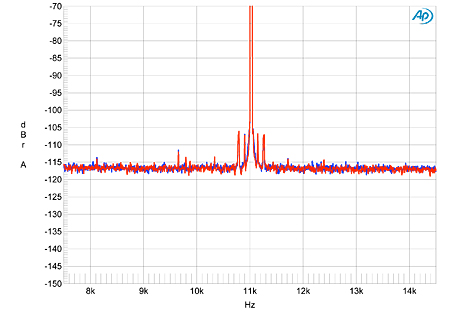
Fig.8 HRT Music Streamer, high-resolution jitter spectrum of analog output signal, 11.025kHz at –6dBFS, sampled at 44.1kHz with LSB toggled at 229Hz, 16-bit data. Center frequency of trace, 11.025kHz; frequency range, ±3.5kHz (left channel blue, right red).
High Resolution Technologies' Music Streamer+ does offer greater resolution than their basic Music Streamer, but neither offers outstanding measured performance. However, the low prices, particularly of the Streamer, should be borne in mind. The point of these products is not to provide state-of-the-art performance at an affordable price; instead, they are intended to offer enough of what is possible from computer-based audio to act as high-end starting points. One caution is appropriate, however, given that music is now becoming available with bit depths greater than 16: Because the PCM2706 chip used in both Streamers truncates the incoming data to 16 bits, it's possible that playing back 24-bit files will result in worse sound than from 16-bit files.—John Atkinson
- Log in or register to post comments




































